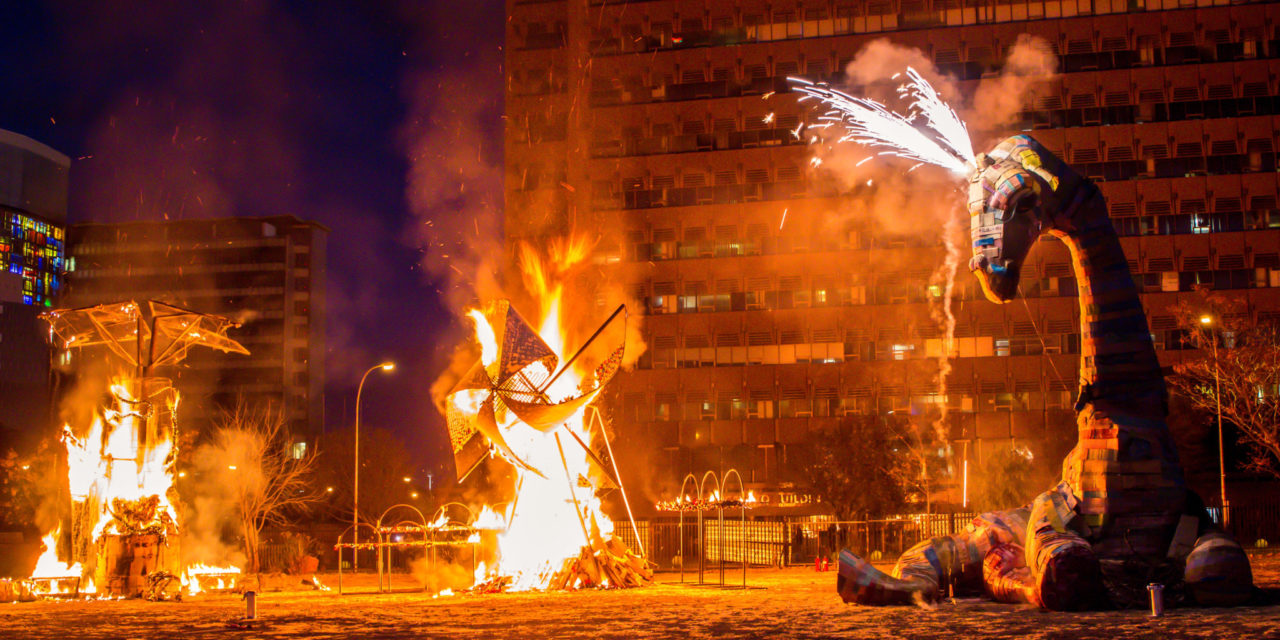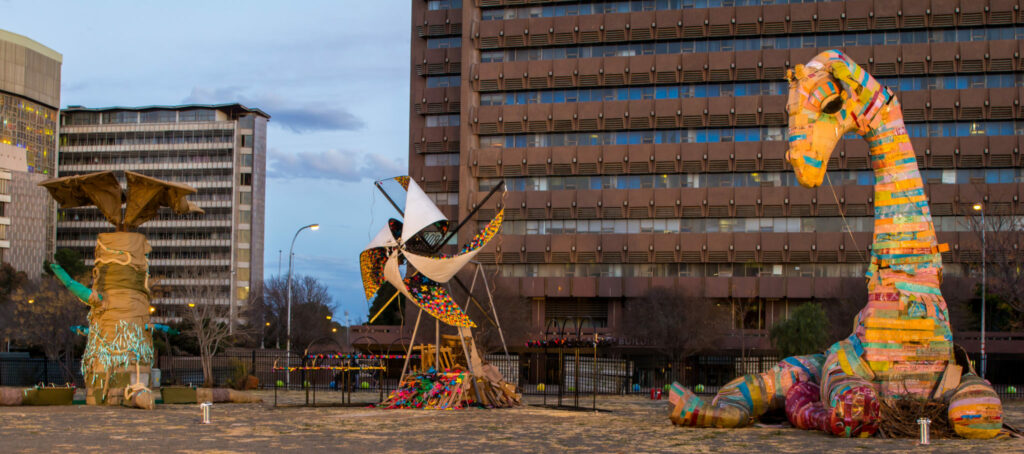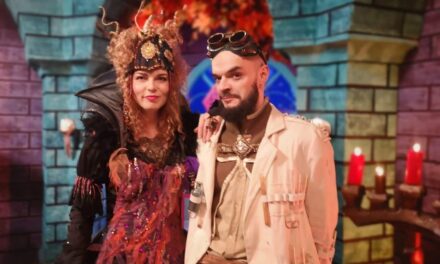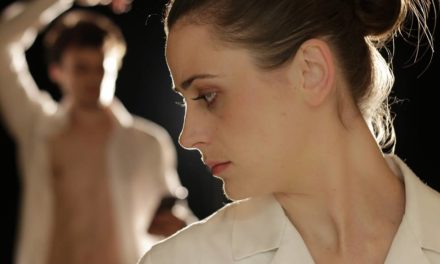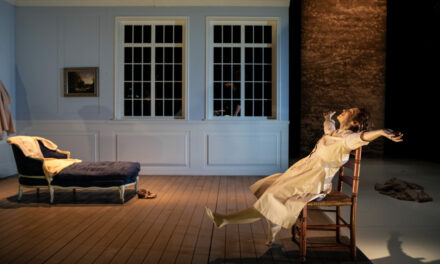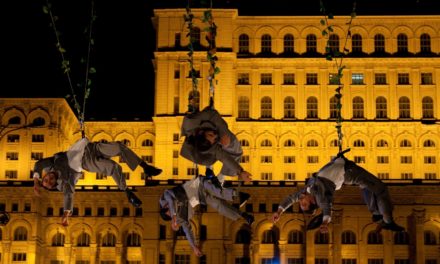The Vrystaat Arts Festival aims to contribute to the exchange of ideas around art, culture, and society through connections with other national and international creative communities. Its vision is centered on the principle of ‘One festival, many stories,’ and its mission is to support the development and presentation of great art in the Free State for all: bringing people together, supporting great art, developing artists and audiences, driving innovation, and playing on the world stage.
The festival’s current five-year strategic plan was developed in 2014 after international, national, and local consultations on what the festival could achieve not just to support the local Free State economy, but also to have a significant impact on South African, African, and global creative communities. Predominantly an Afrikaans-language festival, the festival actively forges creative connections with English and Sotho cultural groups.
Several initiatives (in addition to the main festival consisting of theatre, visual arts, and music) were identified as priorities, including the Programme for Innovation in Artform Development (PIAD), an international literature festival for central South Africa, a fringe festival (vrynge) for emerging artists, significant public art interventions, an Arts and Health programme, and a proposed Pan-African Interdisciplinary Performing Arts Market (PAIPAM).
Collectively, these initiatives aim to increase the creative industries’ footprint in the Free State, create employment opportunities for South Africans, and situate Bloemfontein as one of the key creative hubs of Africa.[i] The Vrystaat Arts Festival, at the core of these initiatives, is the engine that drives this growth.
What follows is a brief description of each of these initiatives. Although they may appear self-contained, as always there is overlap and interdependence that augments each program significantly, and which requires input from the others.
Programme for Innovation in Artform Development (PIAD)
Drawing on a multiplicity of media and disciplines, [interdisciplinary] art practices are the unforeseeable offspring of all the misalliances that make up contemporary experience from popular culture to nanotechnology, from the lived experience of a multicultural society to conceptual art . . . If the [interdisciplinary] arts cannot be described in terms of their ‘thingness,’ they may well be understood as an unruly paradigm for art making, a means of finding new ways to go on, of changing the fortunes of the moment.[ii]
The Programme for Innovation in Artform Development (PIAD) is an initiative developed by the Vrystaat Arts Festival and the University of the Free State (UFS), focusing on how technology, interdisciplinary, and experimental arts can connect with and have an impact on communities.
Co-directed by the Curator of the Johannes Stegmann Gallery at UFS, Angela de Jesus, PIAD was launched in 2014 as a pilot project in response to data indicating that the creative industries in Africa contribute less than 1% to global creative output. [iii]
PIAD fosters innovation in artform development in South Africa through First Nations programmes; arts/science and interdisciplinary artist residencies; interdisciplinary arts laboratories; production and presentation of challenging new work; and critical debates/forums.
As increased access to and participation in culture can be linked to an increase in the Human Development Index, the PIAD focuses in particular on cross-cultural, experimental art programmes that can creatively transform South African society.[iv] For this process the PIAD is working with several South African and international artists to develop mutually beneficial projects, including Dr George Khut (Aus), Dr Keith Armstrong (Au), Abrie Fourie (SA), Erwin Maas (US), Ella Ziegler (Germany), Mabitsela Ignatius Lesiba (SA), and Khanyisile Mintho Mbongwa (SA), amongst others.
In 2015 the Andrew W Mellon Foundation supported aspects of the programme for four years with approximately R7million. This has significantly increased the potential of the programme to make a meaningful intervention in the arts in Africa.
The five components of the PIAD as a result of the Mellon Foundation grant are as follows.
1 First Nations Programme
Dr. Willy Nel, Faculty of Education and Research Associate of the Institute for Reconciliation and Social Justice (UFS), is working in partnership with Lee-Ann Tjunypa Buckskin, Chair of the Aboriginal and Torres Strait Islander Committee at the Australia Council for the Arts over the next four years to develop First Nations programmes and exchanges.
In 2016 Sylvia Vollenhoven’s The Keeper of the Kumm featured in discussions at the Vrystaat Literature Festival, as one of the first First Nation engagements. Kumm is the word for story, history, myth, news or anything recounted in the !Xam (Bushman) language. The book is based on //Kabbo, a /Xam rainmaker imprisoned in CapeTown in the 1870s by the British colonial government, and who narrated his life to linguist Wilhelm Bleek and teacher Lucy Lloyd.
As Dr. Nel suggests: ‘Sylvia Vollenhoven’s book, Keeper of the Kumm . . . delivers a fascinating continued conversation with //Kabbo in the 21st century. Lessons learned from the Australian context in respect of the inclusion and mainstreaming of their First Nations’ arts expressions will assist in the further planning regarding our First Nations’ involvement in the Vrystaat Arts Festival.’
Dr. Nel in partnership with two dancers (Chakwanda Mahongo, a !Xun San youth, and Tristan Coetzee-Nel, of Griqua heritage) and Angelo Mockie also produced The Sun, Dawn and Dusk /Xam Stories for the Vrynge Festival in 2016. The /Xam story of the Sun and its two sons, Dawn and Dusk, was portrayed through dance ‘in a combined style of hip hop/Mime Freak and !Xun San traditional dance. The dance production played out in front of projections of the /Xam cosmology in a combination of graffiti and San rock art’ (Dr Willy Nel, First Nations Coordinator).
A First Nations colloquium is planned in Bloemfontein for October 2016, where a full programme for the next four years will be developed in consultation with representatives from other First Nations peoples, including Indigenous Australians.
2 Arts/Science and Interdisciplinary Artist Residencies
A key aspect of the PIAD is support for world first research through artist residencies around arts/science collaborations. Several international artists are working to develop new, interdisciplinary projects through the PIAD.
In February 2015 award-winning electronic media artist and interaction designer Dr. George Poonkhin Khut (University of the New South Wales) spent three weeks in Bloemfontein to explore locations and opportunities for collaboration on the development of a new brain-wave-controlled interactive art project for the 2017 Vrystaat Arts Festival.
For his residency in 2017, Dr. Khut proposes to create an intimate and immersive public laboratory where visitors will be able to record and share a subtitled video ‘selfie’ of their interaction with the work, that documents the sounds and visual effects generated during their interaction with the Alpha-wave-controlled artwork.
In 2016 Dr. Keith Armstrong (Queensland University of Technology) developed the Re-Future project, which initiates a series of interdisciplinary, intercultural works designed for, and situated within, Mangaung. The project is focused on the intersection of sustainability, community development, and creative action.
Working in collaboration with UFS’s Centre for Development Studies, Anita Venter’s NGO Qala Phelang Tala (QPT/Start Living Green!), QUT Creative Industries and with South African ‘change agents,’ the project seeks to ‘both re-image and bring additional perspectives to QPT’s significant community-empowering, grassroots post-natural building processes.’ Armstrong aims to achieve this through a ‘mobile art experience that helps build new networks of re-futuring throughout some of the poorest informal settlements in the Free State’ (Dr Keith Armstrong, PIAD Artist-in-Residence, 2016).
The tactical media group pvi collective also created transformer in 2016 as a participatory game intent on the creative disruption of everyday life. The residency involved workshops with third-year drama students at the University of the Free State to undertake ‘some serious play and consider ways in which they can creatively transform their immediate surroundings’ (pvi collective, Artists-in-Residence, 2016). Through the workshops with students, pvi created a site-specific game that they performed en masse with the public in Hertzog Square in the city centre of Bloemfontein as part of Public Art Projects (PAP—see later on in discussion).
The transformer game ‘activated players to undertake creative interventions within their immediate surroundings which temporarily transformed the site’ (pvi collective). Players rolled dice to activate each play, with each card activating an action that helped them stimulate their capacity as citizens to enact change in their environment. It was very well received by the public and artists involved in the project, and we are looking at developing a new iteration of the game on a much larger scale in the city centre for 2017.
3 OPENLab Interdisciplinary Arts Laboratories
OPENLab is a national laboratory for early- and mid-career artists and creative practitioners interested in making art in the public realm. The first lab (OPENLab 2014) was developed in 2014 by Australian cultural facilitators Paul Gazzola and Carli Leimbach, with 14 South African experimental artists participating in the 10-day laboratory.
The second iteration of the lab in 2016, OPENLab 2016, was also an intensive residency platform aimed at generating new strategies and ideas in site-specific, experimental and interdisciplinary practice. A second group of 14 artists from across the country were selected to take part in OPENLab 2016.
OPENLab 2016 ‘involved a series of workshops facilitated by the artist Paul Gazzola in Bloemfontein during the course of the Vrystaat Kunstefees before moving onto a second location Modern art projects (Map) South Africa in Richmond, Northern Cape. Facilitators included Abrie Fourie, Ella Ziegler, Mabitsela Ignatius Lesiba and Khanyisile Mintho Mbongwa’ (Bongani Njalo, PIAD Coordinator).
The selected artists were Johandi du Plessis, Karin Tan, Skye Quadling, Scott Eric Williams, Kai Lossgott, Nomusa Musah Mtshali, Kivithra Naicker,Wezile Mgibe, Janet Botes, Victoria Wigzell, Kathleen Sawyer, Yazeed Kamaldien, Lehlohonolo Dube and Sikelela Damane.
One aim of OPENLab is to prepare a new generation of artists to present site-specific work in festival settings, not just the Vrystaat Arts Festival, but also other South African and international events. Several networking opportunities were therefore organized to facilitate meet-and-greet opportunities between the artists and other national and international festival directors and heads of arts organizations who were present at the festival in 2016.
It is proposed to work with other festivals in the future to provide presenting platforms for OPENLab alumni.
4 Production and Presentation of New Work
Each year PIAD commissions new, experimental work from both national and international artists to be presented at the Vrystaat Arts Festival. Works such as Cigdem Aydemir’s Plastic Histories, Lesiba Mabitsela’s The Man With the Green Blanket, Jess Olivieri’s The White Horse Project, Sethembile Msezane’s Love in the Time of Afrophobia and Nieke Lombard’s Falma are examples of how the PIAD supported the presentation of new work.
In 2016 the British artist Alex Rinsler’s It’s My City was presented as the key PIAD new work project. It’s My City was a large-scale public art and community project that took place in several parts of Mangaung, including the city centre of Bloemfontein, Batho Location and the UFS campus, alongside the Vrystaat Arts Festival. It’s My City also formed part of the UFS’s Human Project, which supports transformation, cultural understanding and appreciation of others.
It’s My City, curated by Angela de Jesus and produced by Corneli van den Berg, brought together local and international artists working with three self-selecting communities to promote social cohesion for the people of the city of Mangaung. Three sculptures were built: a Baby Giraffe, a Mothertree and a Toy Windmill.
Lead artist Alex Rinsler managed the team of local artists including Marius Jansen Van Vuuren (Baby Giraffe), Tshiamo Art and Crafts Development (Loki Maselwane, Itumeleng Moamogwa, Tshegofatso Marogoa—Mothertree) and Minè Kleynhans (Toy Windmill) with performance director Nieke Lombard creating a community gathering on the last day of the festival, where all three sculptures were gathered together in the heart of the city and set alight in a spectacular fire ceremony, to unite communities rather than separate them.
The project ended in a gathering of more than a thousand people in the city centre with fireworks concluding an event more than a year in the making. As an intervention in the city, bringing together people from a range of communities in a moment of joy, it was a resounding success.
5 Critical Debates/Forums
Innovation in artform development takes place when dialogue between various artforms are encouraged and relationships with disciplines outside of the arts facilitated. These linkages lead to the development of new artistic and scientific languages, new ways of thinking, groundbreaking community engagement and cutting-edge processes for producing and presenting culture.
It is from within these interdisciplinary spaces that some of the most exciting and innovative art emerges—not because of easy similarities, but because of difficult but rewarding discourses that develop when people from different and often contradictory disciplines learn to communicate with each other and create work.
It is often complex to communicate initially as art, requiring long-term support and iterative engagements, but it is essential for the development and evolution of culture and the arts. Facilitating a debate, national and international art forums, lectures, critical writing and seminars is. therefore. essential to contextualising this innovation in artform development.
In a 2016 keynote, Alison Tickell, CEO of Julie’s Bicycle, with respondent Rosemary Mangope, CEO of the National Arts Council of South Africa, and facilitator Mike van Graan, Executive Director of the African Arts Institute, led a forum titled ‘Cultural Sustainability in Environments of Change.’
Julie’s Bicycle is a leading global charity “bridging the gap between environmental sustainability and the creative industries.’ Their vision is ‘a creative community with sustainability at its heart’ and a mission ‘ to provide the inspiration, expertise, and resources to make that happen.” They work with over 1,000 arts organisations across the UK and internationally, large and small, to help them measure, manage and reduce their environmental impacts (Julie’s Bicycle).[v]
The forum explored how arts could engage more significantly with environmental sustainability in South Africa. Some cultural practices—such as international touring—have significant carbon footprints, yet are essential for the development and sustainability of the arts. The forum asked how cultural practitioners could learn to negotiate the fine line between cultural development, sustainability and responsibility towards the environment.
As a result of this year’s focus, there is scope to source funds to employ South Africa’s first Arts and Environmental Sustainability Coordinator by 2017. There will also be some critical writing commissioned to assess where South Africa is currently and what some of the steps are that artists and arts organisations in the country could take to become more sustainable. The Vrystaat Arts Festival will also look at its carbon footprint and see what steps are possible to take over the next few years to increase its sustainability focus.
Notes:
[i] Currently unemployment rates in the Free State are around 40% for young people (ages 15–34) and 20% for adults (ages 35–65). Increasing the creative industries in the state would create employment, particularly for young people. (http://www.statssa.gov.za/publications/P02114.2/P02114.22015.pdf; accessed 15 August 2016).
[ii] Sarah Miller, “Hybrid Art: Cultural Biodiversity,” in In Repertoire: A Guide to Australian New Media Art, edited by Keith Gallash (Sydney, Australia: Realtime Publications, 2003), 13.
[iii] United Nations Conference on Trade and Development (UNCTAD) Report, 2010, quoted in Mike Van Graan, “African Creative Industries, the Sleeping Giant,” edited by Anver Versi, African Business, no. 405, London, February 2014, p. 16. (http://issuu.com/icpubs/docs/ab0214_lr). ‘The report reveals that Africa’s share of the global creative economy stands at less than 1%.’
[iv] Sakina Badamasuiy, “The Case for Investing in Africa’s Creative Industries,” Afrimind, 5 April 2013 (http://www.afrimind.org/article/49/the-case-for-investing-in-africas-creative-industries.html).
[v] Julie’s Bicycle, “About” (http://www.juliesbicycle.com; accessed 15 August 2016).
This post was written by the author in their personal capacity.The opinions expressed in this article are the author’s own and do not reflect the view of The Theatre Times, their staff or collaborators.
This post was written by Ricardo Peach.
The views expressed here belong to the author and do not necessarily reflect our views and opinions.

